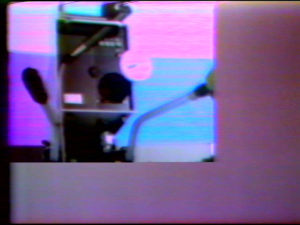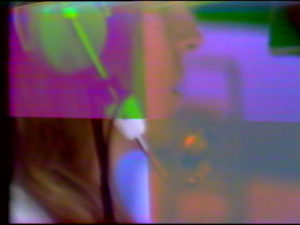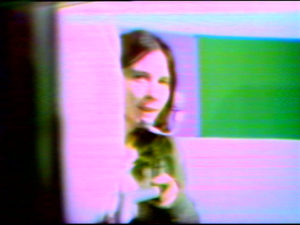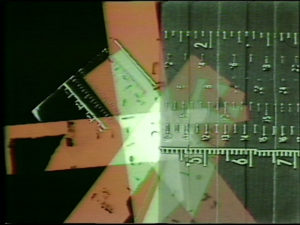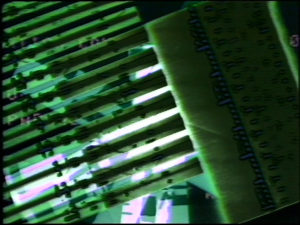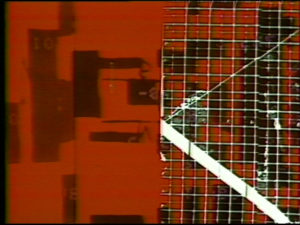Katharina Neuburger on
Keith Sonnier
The five senses have interested me right from the start. KEITH SONNIER, 1993[1]
Considered an influential member of the Process Art movement as well as a Conceptual artist, Keith Sonnier (American, born July 31, 1941) produces work that engages in a critical analysis of the tradition of sculpture. His approach to installation, however, extends his work beyond any restrictive definitions of this medium. His installations often incorporate painting, drawings, environments, film, video, and sound, while utilizing materials like neon and incandescent light, glass, mirrors, latex, cheesecloth, satin, cotton, rope, wood, as well as found objects and the technical apparatuses used in the works’ creation. Art critic and curator Bruce Kurtz has remarked that “… the most unique quality and the greatest strength of Sonnier’s art is that it deals with an integration of color, surface, space, and material unlike any other art.”[2]
Born in Mamou, Louisiana, Sonnier has produced an eclectic oeuvre influenced as much by the rural world of Louisiana’s Creole people as by his studies at the University of Southwestern Louisiana (BA, 1963) or his time as a student at Rutgers University, where he received his Master of Fine Art in 1966. After this, Sonnier joined the informal “Rutgers Group,” led by Robert Morris, where his work’s post-minimalist aesthetic was strengthened and found new direction despite Morris’s own stylistic alignment at that point. When curator and art theorist Lucy Lippard invited Sonnier to participate in the 1966 exhibition Eccentric Abstraction,[3] he became part of a group that was quite explicitly taken up with counteracting the Minimal Art movement so dominant at the time. Sonnier’s sculptures from this period, such as Walk In (1967) or Lay In (1967), both early cloth pieces, as well as the Files (1968–69), for which he experimented with variations on that common tool’s form using molded and formed brass and aluminum, show the artist’s interest in the significance of the sensual and psychological attributes of his materials. In an interview with Barbara Bertozzi Castelli, he explained: “Latex … is an industrial material but it looks like skin and it has a sort of animalistic heritage. Satin is a very suggestive material, too …. My choice of objects and materials … was more about how they related to the senses.”[4] Around 1968, neon light fixtures began to appear as a defining element in many of Sonnier’s series, for which he combined large-scale, prefabricated glass panes, mirrors, foam rubber, and blackboard paint with luminous neon shapes. Art critic and curator Robert Pincus-Witten has suggested that these works were “… directed to answering the question of how to structure light and, in so doing, how to be art.”[5] By incorporating reduced geometric forms and emphasizing their role in the shaping of space, Sonnier also engaged more directly in these works with analytical compositional approaches such as the application of the golden mean.
Also in 1968, Sonnier began showing both in Cologne at Rolf Ricke’s gallery and in New York at Leo Castelli’s Warehouse on West 108th Street. Sonnier’s works first appeared at the latter space as part of 9 at Leo Castelli,[6] organized by Robert Morris. Sonnier contributed three works to the show: an untitled installation, Mustee, and Rat-Tail Exercise—two early flock and string, and one early neon and cloth piece. These works focused on subtle transformations of forms and materials with which Sonnier created “con-textual” fusions instead of mere material juxtapositions. In 1969, curator Harald Szeemann invited Sonnier to participate in the landmark show Live in Your Head: When Attitudes Become Form (Works – Concepts – Processes – Situations – Information).[7] There, he displayed his work Flock Piece (1969), which consisted of latex and flocking (shredded rayon fiber). This installation work was purchased by Rolf Ricke immediately after the exhibition[8] and is now part of the Ludwig Forum collection. Sonnier was also included by curator Marcia Tucker in the first large-scale exhibition of Post-Minimalism in New York, entitled Anti-Illusion: Procedures/ Materials.[9] The installation works from this period were easily transportable and Sonnier would frequently alter them for different exhibition spaces. Site-specificity was important to him insofar as a work could be made to react to various art spaces.
In the early 1970s, Sonnier created the series T-Hybrid-V, a work which furthered his ambitions to unite various media, originating in his understanding of their differing degrees of intimacy: “We will never expect the grand things from video that we expect from theater and film. They come by surprise and indirection. Video is closer to life than its competitors. Video is mind to mind, not mind to public. The audience is potentially huge, but intimate.”[10] T-Hybrid-V-I, also now at the Ludwig Forum, is a video in which a split-screen image of reshot (or “kinescoped”) scenes from daytime television are combined with several black-and-white sequences shot by Sonnier in his studio and elsewhere. The piece was created by shooting a video monitor showing the television broadcasts and the artist’s recordings with alternating halves of its screen covered. Sonnier, using an early video special-effects generator, could subsequently “… ‘paint’ on the previously recorded black-and-white videotape with artificial hues.”[11] Indeed, such works as these, along with his sculptural installations, are related to the color painting of the 1960s via the artist’s conceptualization of color and light in “painterly terms,”[12] though he was mainly interested in “color as volume.”[13] The Ludwig Forum for International Art, in Aachen, possesses an original film copy of the piece: Sonnier preferred works such as T-Hybrid-V to be shown as film projections, whose scale and strong colors allow for viewers to be immersed in the image frame and experience the projections as a spatial installation.[14] With the combination of media, a collage-like formal alternation between the tinted monochrome of film and the strong, abstracted colors of video emerges. Acting against the potential for the piece to be ordered into split-screen and color/ black-and-white dichotomies, Sonnier inserted shots of faces in close-up to act as both narrative and structural disruptions. The faces can be seen, and sometimes heard, counting down: first that of a man doing so in Spanish, then of a woman in Chinese, and, finally, of the artist in English. The work’s split-screen format, its juxtaposition of various camera perspectives, and the alterations created by the video effects combine to produce a seemingly improvised, though highly complex, visual structure. In an interview with Barbara Castelli, Keith Sonnier commented that, with the T-Hybrid-V he “… wanted to make things in relation with the object of the television and the experience of viewing, where the performer is in front of the TV and talks to the TV.”[15]
Color Wipe, 1973, video stills © Keith Sonnier, VG Bild-Kunst, Bonn
Sonnier often includes documentation of the activity of producing his works within the works themselves, thus creating a visual and/or aural meta-level of content in which the process literally becomes the work. Color Wipe, another artwork in the collection of the Ludwig Forum, is such a process piece. For this 1973 video work, Sonnier, sitting in a control room, mixed the feeds of two video cameras “… handled almost like machine guns …”[16] by Tina Girouard and Suzanne Harris. The resulting recording of this process occasionally reveals the two camerawomen and their equipment. At one point, we see the “image” of the two cameras recording each other face to face. The viewer can hear all three of the performers’ conversations with each other but sees only partial images of the two camerawomen. The audio track contains both dispassionate instructions and vaguely poetic expressions: “Lilac is blue,” one of the operators states, while her colleague enumerates the generator’s possible effect variations. From his control room, Sonnier instructs the movements of the operators in the studio, while also simultaneously creating video wipe, cropping, and scaling effects as the cameras move according to his commands. Several painted color panels are at times visible on the studio’s wall, installed to resemble video color bars. Reacting to the color panels which the cameras face, the artist at his controls modifies or inverts the colors seen in the resulting video work. The vertical and horizontal movements of the cameras cause the image of the color panels to blur and flicker as though they are themselves monitors. In many ways, Color Wipe is a work about the possibilities and limitations of its own medium. Within the layers of recorded sequences, manipulated images, and technological disruptions, a hybrid consisting of the documentation of the creative act and a scientific experiment is created.
Animation II, 1974, video stills © Keith Sonnier, VG Bild-Kunst, Bonn
Animation II (1974), the Ludwig Forum’s third video/ film work by the artist, also strongly emphasizes the process of creating images. The video is a document of the process of manipulating and programming with a CAESAR video synthesizer, an early cartoon and text animation tool. Taped at Computer Image in Denver, Colorado, Sonnier’s video documents his investigation of the computer’s parameters, animations, and the computer screen itself. For Animation II, Sonnier used all seven inputs of the computer to combine real-time information with stored source materials. He utilized every possibility the computer offered for the alteration and/or animation of inputted visual data while also documenting the code language used to produce these effects. In the video, this data can be heard read aloud by a female voice along with Sonnier’s verbal instructions to the computer technicians. Before the viewer sees it, she hears the artist explain or command how the image should be manipulated. “I want the full view of the artwork,” Sonnier instructs at one point in the video.
Like his early installations and video pieces from the 1970s, Sonnier’s more recent oeuvre is complex and wide-ranging. During the 1980s, Sonnier began to travel and exhibit in Southeast Asia, Brazil, Japan, and Indonesia while also initiating many ongoing art-in-architecture projects internationally. Work on his series often spans years or even decades. BA-O-BA, for example, has been undergoing changes for over forty years, including temporary installations such as a site-specific installation in Gordon Bunshaft’s Lever House (BA-O-BA Lever House, 2003). The work takes its title from the Louisiana Creole term for the effect of moonlight on human skin.[17] Sonnier has suggested a connection between the almost tactile experience of natural light suggested by this term and early childhood memories of his family’s movie theater: “When the film would come down,” the artist remembered, “you would enter into the fantasy at the movie theater: this was a unique experience, very different than watching television.”[18] Working in BA-O-BA to combine these two forms of experience, the immediate and sensual with the subjective and artificial, Sonnier installed colored neon light tubes of different shapes along with glass plates and mirrors. The architectural aspect of this installation lent itself to being transformed into a temporary neon installation for Peter Zumthor’s Kunsthaus Bregenz in Austria, entitled Millennium 2000, and into a permanent installation entitled Motordom (2004) in Los Angeles, for which the four-story outdoor lobby of the Caltrans District 7 Headquarters was interwoven with a half mile of red and blue neon and argon tubes. Though these more recent projects are considerably larger in scale, they still bear the artist’s characteristic orientation towards a sense- and experience-based intimacy.
Sonnier has been widely exhibited and his work can be found in many of the most distinguished public and private collections internationally as well as in many prominent public and architectural spaces. However, the significance of his video work, with its innovative merging of painting, sculpture, and video, remains underestimated. It finds itself at an extraordinary and thus somewhat unexplored location of interaction between the canonical media and a contemporary understanding of their installation in space.
[1] Keith Sonnier in an interview with Hubertus Raben, Lichtweg / Keith Sonnier / Lightway, ed. by Renate Puvogel, Stuttgart, 1993, p. 26.
[2] Bruce Kurtz, “Video Is Being Invented,” Arts Magazine, December–January 1973, p. 38.
[3] The exhibition Eccentric Abstraction at Fischbach Art Gallery New York was open from September 20 to October 8, 1966, and the participating artists were Alice Adams, Louise Bourgeois, Eva Hesse, Gary Kuehn, Bruce Naumann, Don Potts, Keith Sonnier, Frank Lincoln Viner.
[4] Keith Sonnier in an interview with Barbara Bertozzi Castelli, Castelli Warehouse 1970 / Castelli Gallery 2015, exh. cat., New York, 2015, p. 16.
[5] Robert Pincus-Widen, “Keith Sonnier: Video and Film as Color Field,” Artform, May 1972, p. 35.
[6] The exhibition 9 at Leo Castelli at Castelli Warehouse was open during December 1968, and participating artists were Giovanni Anselmo, Joseph Beuys, William Bollinger, Rafael Ferrer, Eva Hesse, Stephen Kaltenbach, Bruce Naumann, Alan Saret, Richard Serra, Keith Sonnier, and Gilberto Zorio.
[7] The exhibition Live in Your Head: When Attitudes Become Form (Works – Concepts – Processes – Situations – Information) at the Kunsthalle Bern, Switzerland, was open from March 22 to April 27, 1969. The show was recently reconstructed under the title When Attitudes Become Form: Bern 1969/ Venice 2013 at the Fondazione Prada, Venice, by Germano Celant, Thomas Demand, and Rem Koolhaas. The Venice exhibition was open from June 1 to November 3, 2013.
[8] Transcript of a conversation between Keith Sonnier, Brigitte Franzen, and Miriam Lowack, November 3, 2013, Studio Keith Sonnier, New York City, p. 1 ff.
[9] The exhibition at the Whitney Museum of American Art, New York, was open from May 19 to July 6, 1969.
[10] Douglas Davis, “Video Obscura,” Artforum, April 1972, p. 67.
[11] Ibid., p. 68.
[12] Pincus-Widen 1972, p. 35.
[13] Keith Sonnier in an email to the author, January 5, 2017.
[14] Transcript of a conversation between Keith Sonnier, Brigitte Franzen, and Miriam Lowack, 2013, p. 6.
[15] Keith Sonnier in an interview with Barbara Bertozzi Castelli, 2015, p. 26.
[16] Lizzie Borden (videotape descriptions), “Color Wipe,” Castelli-Sonnabend. Videotapes and Films, Vol. 1, No.1, November 1974, p. 126.
[17] For a discussion of the term “ba-o-ba,” see Keith Sonnier in an interview with Barbara Bertozzi Castelli, 2015, p. 23.
[18] Ibid., p. 23.
